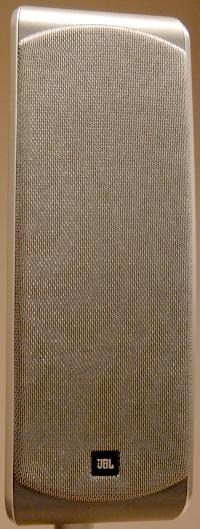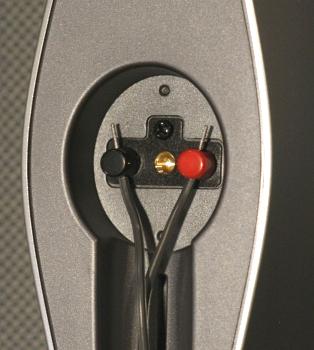Introduction
When asked to review the JBL speakers for my first review, I enthusiastically
agreed, but I must be honest - I was skeptical of how seven small satellites and
subwoofer would compare to my full-range Dynaudio 3.0 speakers, REL Strata
III sub, and Axiom QS8 rear channel speakers. After all, the entire JBL
package cost less than my center channel speaker!
It had literally been years since I last listened to an HTIB (Home Theater
in a Box) product. My impression of those speakers back then was as if I were listening to a movie in a shower
stall. Sure the sound surrounded me, and there was lots of ambiance, but it
was harsh, and more distracting than enjoyable.
Let me cut to the chase and say that the JBL SCS300.7 speaker system was surprisingly enjoyable
and very satisfying to use when watching movies. It consists of seven
satellite speakers and a subwoofer.
Installation
The first thing one notices when unpacking the speakers is the amount of
speaker wire provided: three 20 foot cables, two 15 foot cables, and four 40
foot cables. All cables come stripped and tinned which is a nice touch
because the terminals on the speakers are quite small and will not accept larger
gauge wire, spades, or banana plugs.
At first I found this to be annoying
because the large five-way binding posts on my amplifier dwarfed the small
gauge of the wire provided. Of course the cables worked, but they seemed
flimsy in comparison to the spades used on my reference cables. Then I
reminded myself that most people will probably use this system with a
receiver or integrated processor that will have less substantial binding
posts.
The SCS300.7 allows for three methods of mounting the speakers, namely the included
shelf-stands, the included wall mount brackets, or optional floor-stands. The
shelf-stands are sturdy enough (although the speakers did bob a little if I touched them) and would work well placed in a media cabinet as long as
your shelves have enough vertical clearance.
Because my room does not have any shelves, and I was not willing to drill holes
in my walls for reviewing the speakers, I used the floor-stands.
The T1000 floor-stands are
sleek and stylish. They complement the look of the satellite speakers and do
a nice job of concealing the speaker wires. Although they were
quite stable on hardwood or tiled floors, they were easily tipped on
plush carpet. It would have been nice if there were a way to use spikes with
the stands, but again that is a feature that is not often found on products
like this. If you require stands for carpet use, the floor-stand adaptors
are compatible with a 1/4"-20 threaded insert which can be used with stands
from other manufacturers.
 The
wall brackets really seem like the best option because would let you to
mount the speakers anywhere and provide a ball and socket joint allowing you
to tilt the speakers in any direction to achieve the best sound. If you can
manage to run the speaker wires through the walls (at least to the trim
along the floor), you will have a nice clean installation.
The
wall brackets really seem like the best option because would let you to
mount the speakers anywhere and provide a ball and socket joint allowing you
to tilt the speakers in any direction to achieve the best sound. If you can
manage to run the speaker wires through the walls (at least to the trim
along the floor), you will have a nice clean installation.
In addition to the seven satellites, the SCS300.7 includes a nice subwoofer and
a 15-foot RCA cable to connect it to your receiver. The subwoofer will accept LFE input from a Dolby
Digital/DTS connection as well as a Line Level input from a non-digital
source or speaker level inputs. I only used my processor's LFE output for
this review.
Set-up
Set-up of the SCS300.7 was a breeze using the LFE input on the subwoofer. I
configured my processor as described in the owner's guide, setting the front
left, front right, center and rear speakers to "Small." Then I adjusted the
crossover frequency between the subwoofer and the main speakers to 100 Hz.
Next, I calculated and set the delay for each speaker depending upon its
distance from my main listening position.
When I first started listening to the SCS300.7, I was using all seven speakers in a
7.1 setup. However, my room is rather small (14' x 11'), and I found the
placement of four direct radiating speakers only about 4 feet from my head
distracting even after adjusting the levels. The sound was simply too
directional for my tastes. Perhaps I am used to the dipoles, but I suspect
the problem was with the proximity. As mentioned earlier, I believe mounting
the speakers on the wall and having them further away would have had
provided a very nice effect. I removed two of the speakers and finished my
listening using a 5.1 configuration placing the satellites as far away from
me as possible. While still somewhat directional, the sound was less
distracting this way.
Once all the basics were covered, it was time to fine-tune my system using
Avia and DVD Essentials. This is when I had my first surprise. During the
Phase/White Noise test, I discovered a significant difference in timbre
between the center channel speaker and the left and right mains. My first
inclination was to blame the difference on the dispersion patterns of the
speakers. The left and right speakers were oriented vertically while the
center had a horizontal orientation. As a test, I placed the center speaker
vertically but the difference was still very apparent. Next, I swapped the
speaker for another one thinking that perhaps the one I was using was
defective, but there was no difference. This made me examine my system more closely. As
it ended up, I was using a different cable for the center channel from the
processor to the amp than I was using for the left and right channels. I
quick swap of cables and the difference in timbre was gone. If nothing else,
I knew the SCS300.7 speakers were revealing!
 Music
Music
As I mentioned earlier, the SCS300.7 speakers were surprisingly satisfying
to listen to. I started with my usual Redbook CDs that I use for music
auditions. First up was, Eva Cassidy - Live at Blues Alley. Her version of
Sting's "Fields of Gold" on this CD is remarkable at giving you a feeling
for the venue (which happens to be close to where I live) and purity of her
voice. However, there is a lot of reverb on the track that can be overemphasized on some systems.
Despite their small size the JBL's were not
overly bright or harsh. However, I don't believe the speakers were able to
totally convey the richness of Eva's voice. At $699 though, not bad.
Next, I listened to Jacques Loussier Plays Bach. Track 6, "Air on a G String"
is great for listening to the acoustic bass. During the bass solo, many of
the notes are played in the upper registers of the instrument, but the
performer also hits plenty of low notes as well. The JBLs were able to
reproduce the music nicely, though I wouldn't call the performance detailed.
The extension was there, so the music didn't disappear (as in no sound being
reproduced by the subwoofer), but it wasn't exactly tight or well defined.
Another favorite CD is Lyle Lovett, Joshua Judges Ruth. I have this
recording on CD as well as a DTS version. Lyle's voice has a rich quality
that I find very soulful when reproduced well. The DTS version is
terrific at placing Lyle in the room with you. The JBLs did nice job
conveying this illusion.
In general, the JBLs performed nicely but - of course - simply didn't have the authority
to really make the impact that my Dynaudio speakers have. Nevertheless, the speakers were pleasant to
listen to and certainly better than any satellite system I have listened to
in recent memory.
Movies
Where the SCS300.7 system really excelled was with movie soundtracks. I was
especially impressed with how seamless the panning of effects from front to
back and side-to-side was. I think this can be attributed to having matching
speakers for all channels. Just as I have a few favorites for auditioning
music, I have a few movies that I always turn to for evaluating performance.
While it may seem an unusual choice, Scrat's Missing Adventure on the Ice
Age DVD is great for listening to panning effects. There are a variety of
scenes that involve acorns coming at you, then past your head, or from side
to side. As I mentioned before the panning was seamless and really
contributed to the effect. The rumble of subwoofer as the continents
separated is terrific and adds to the fun of this amusing video short.
The opening beach scene of Saving Private Ryan is another terrific scene for
auditioning a system (I just wish it wasn't so depressing). With the crash of the
waves, the gunfire, and the explosions, the SCS300.7 provided a convincing
performance. Especially convincing was the zing of bullets going past your
ears and ricocheting off objects. I found myself wanting to brush my ear
as if a mosquito was buzzing too close.
Another impressive battle scene is the opening of Gladiator. The arrows and
catapults were effectively reproduced from side to side and back to front.
However, before the serious action begins, there is a scene where Maximus is walking
through a field letting his hand brush against the tall grass and the wind
is blowing around him. You can almost imagine the air swirling around you.
The sound of the grass swaying and being crushed below footsteps is very
subtle, but reproduced well by the JBLs.
In addition to the effects, the SCS300.7 did a very good job with dialogue -
which is harder to reproduce accurately than a processed effect. Voices were
never overly chesty or sibilant - basically they sounded natural although
sometimes a little congested on deeper male voices.
Conclusions
My audition of the JBL Surround Cinema Speakers - SCS300.7 was very
enjoyable. Most of my time with them was spent watching movies. The seamless
integration of all the speakers resulted in excellent sound and providing a
convincing cinema experience. In particular, I feel this system is
especially well suited for someone looking for speakers to match with a mass
market 7.1
receiver and a flat-screen television mounted on the wall.
- David B. Bliss -